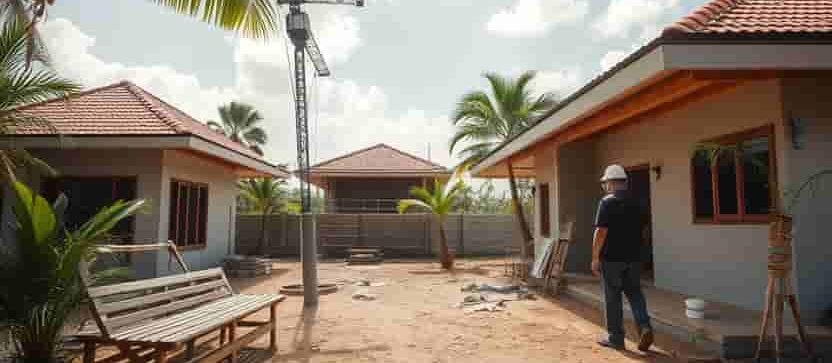- About Us
- Legal Services
- Family Law
- Property
- Marriage
- Immigration
- Contact
- Payments
This is a brief overview of the Building Control Act in Thailand. There are a number of section on this website. There is the building a theatre on Thailand. There is also the section on building control act inspectors. Likewise there is also the construction permit fees. If you need to speak to a construction license lawyer then speak to us online. This is summary of the Act and should not be bookmarked as it is for comparison only.

Building Control Act
Building Works, Construction, Demolition and Relocation
You will note that Chapter 3 of the Building Control Act outlines what should be considered the requirements for construction in Thailand. This also cover modification as well as demolition of a building structure. The permit process as well as additional compliance check have been included. The framework of the Act is to ensure public safety as well as a structural integrity.
Before building, modifying, or relocating a structure, you must:
1. Get a permit from the local authority, or
2. Inform the local authority per Section 39bis requirements.
Note however that there may be an exception should qualified top-grade architects and engineers who designed the structure. Then notification may suffice instead of a permit.
When certain buildings require design and structural review, applicants (whether seeking a permit or notifying under Section 39bis) must ensure all plans and calculations comply with the rules set by MR.
For demolishing a building, you must:
1. Get a permit from the local authority, or
2. Notify the local authority under Section 39bis, especially if:
– The building is over 15 meters tall and close to other structures, or
– The building is less than 2 meters from other structures or public areas.
( SECTION 23 Repealed in 1992)
( SECTION 24 Repealed in 1992)
Once a permit application is submitted, the local authority must respond within 45 days with either a permit or a rejection notice, providing reasons if rejected. Extensions of up to two additional 45-day periods may be granted, with timely notice to the applicant each time.
If the building requires licensed professional oversight (engineering or architecture), the application will be denied if the listed professionals lack the necessary licenses under their respective professional laws.
The local authority may require applicants to correct or update their site plans, designs, specifications, or calculations to meet the MR and local regulations. Once corrected, the authority must decide within 30 days. Major changes may require a new application.
For buildings with engineering designs by licensed engineers, the local authority reviews all non-calculation aspects of the application.
For buildings with architectural plans by licensed architects, the local authority reviews all aspects except internal architectural details, except in the case of fire safety elements.
After receiving a permit, the permit holder must inform the local authority of the project supervisor’s name, work start date, and anticipated end date, along with a consent letter from the supervisor.
If a supervisor’s role ends, the permit holder must notify the local authority and temporarily stop work until a new supervisor is designated.
Any building work must strictly follow the approved site plans, design plans, and specifications. Changes require a permit or notification to the authority unless they do not conflict with MR or other relevant bylaws.
Certain building types (e.g., warehouses, hotels, medical facilities) must notify the local authority upon starting work for inspection purposes. Use of the building for specified activities is prohibited until the authority certifies compliance. Likewise see also the Hotels Act as well as the Factory Act.
Owners of specific buildings (e.g., high-rise or public buildings) must have licensed inspectors evaluate safety systems and submit reports for review by the local authority to ensure health, life, and property safety.
Buildings not designated for certain uses cannot be used as such without a permit or notification to the local authority.
Designated parking or access areas cannot be modified or used for other purposes without local authority permission.
Permits are valid only for their designated period. Renewals must be applied for before the permit expires.
Permits are non-transferable without written local authority approval.
Upon a permit holder’s death, heirs or estate administrators wishing to continue work must notify the local authority within 90 days.
During any licensed building work, copies of the permit, plans, and specifications must be available on-site for inspection.
Lost or damaged permits must be replaced by submitting an application to the local authority within 15 days.
Those who opt to notify the local authority instead of seeking a permit must submit required documents, including professional licenses and certified plans, and may begin work upon receiving notification acknowledgment from the local authority.
Building Control Act
Building Control Act
Building Control Act
Building Control Act
The Certificate of Utilization is explained on this page. You will need to understand the building utilization certificate if you are going to build in Thailand. Speak to us today about your building.
If you are building your house in Thailand then consider the costs for the permits. You will note that cost from everything for the construction permit cost to the demolition permit costs.
Effective Date: Enforced 60 days after publication.
Key Sections:
– Section 1: Name of the Act – “Building Control Act (No. 2) 1992.”
– Section 2: The Act becomes effective after 60 days from publication.
– Sections 3–26: Amendments to the 1979 Act are included in the main text and thus omitted here.
– Section 27: The existing Appeal Committee remains in office until a new committee is appointed under this Act.
– Section 28: Applications for permits submitted before this Act’s enforcement will be considered under the 1979 Act unless withdrawn within 30 days of enforcement.
– Section 29: Local officers must commence improvements on burnt areas within two years of enforcement.
– Section 30: Existing regulations and orders remain in effect unless in conflict with this Act.
– Section 31: The Minister of Interior oversees this Act.
– Revise provisions for flexibility and appropriateness.
– Facilitate the notification process for construction activities.
– Improve local officer enforcement capabilities.
– Adjust penalties and powers of comparison committees.
Effective Date: Enforced 180 days after publication.
– Section 1: Name of the Act – “Building Control Act (No. 3) 2000.”
– Section 2: Enforced after 180 days from publication.
– Section 3: Repeals the Prevention of Hazard Deriving from Entertainment Act 1921.
– Sections 4–30: Revisions of the 1992 amendments are included in the main text and thus omitted here.
– Section 31: Regulations citing the theater under the repealed act are now considered under the BCA 1979.
– Sections 32–36: Applications and permits under the repealed act continue as valid under the amended BCA 1979.
– Section 37: Existing regulations remain valid unless inconsistent with this Act.
– Section 38: The Minister of Interior oversees this Act.
– Update building control regulations to reflect current conditions.
– Integrate theater use regulations into the building control framework.
– Address new safety and environmental standards in building practices.
Effective Date: Enforced the day after publication.
– Section 1: Name of the Act – “Building Control Act (No. 4) 2007.”
– Section 2: Immediate enforcement upon publication.
– Section 3: Introduces provisions for buildings developed by state agencies for low-income housing while maintaining safety and stability standards.
– Support government policies to address poverty and enhance living conditions for low-income individuals.
– Facilitate low-cost housing development without compromising safety standards.
Browse the rest of the website to see more on boiling in Thailand. Speak to us about your plans on building you house in Isaan or anywhere else in Thailand. This is a very brief overview of the building control act in Thailand in English. Lastly also see the building utilization certificate in Thailand explained on this website.
The information contained in our website is for general information purposes only and does not constitute legal advices. For further information, please contact us.
